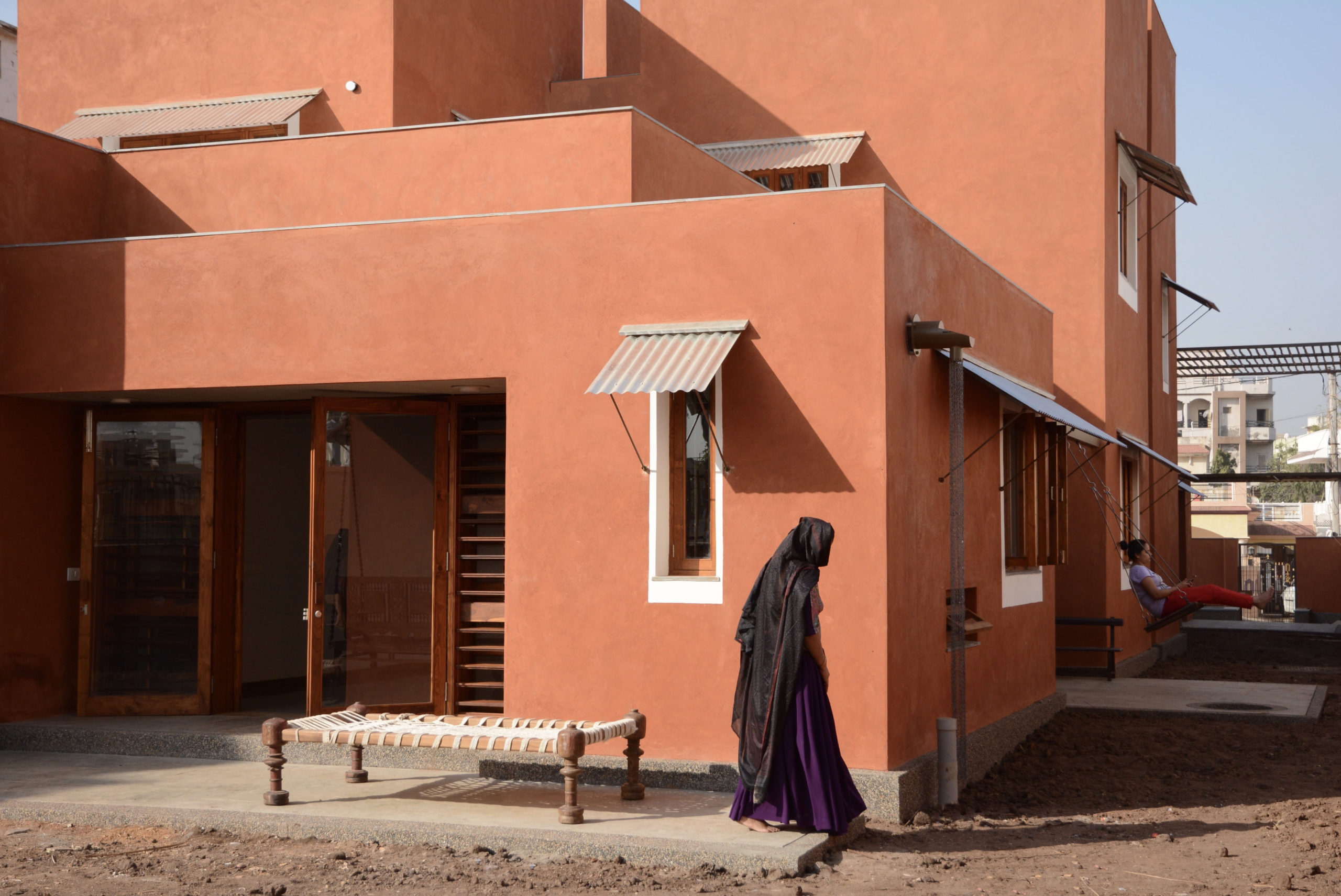
This is a house for the Dhila family which engages in agriculture and dairy farming. They belong to a village called Dagara in Kutch. The site is in Adipur, which is part of the twin, planned towns of Adipur-Gandhidham in south-eastern Kutch. Adipur grew in prominence in post partition India as a planned town with a mix of indigenous communities and refugees from Sindh, Pakistan.
Arrays of plots divided by broad streets organised around squares and public open spaces, define a typical residential neighborhood character.. The plot of land here was linear and deep with an area of approximately 1000 sq.m oriented west-east along the longer axis. A road abutted the western edge of the plot with a small open plot to the east. Low rise residential buildings flank the northern and southern edges.
The family comprises three generations, the youngest being six and the oldest about seventy with a strong connection to their community and societal engagements. The main components of the brief, apart from the usual requirements of a simple home, emphasized the need to be self-sufficient with water, thermal comfort, use of appropriate materials that would enhance building resilience to counter the seismic forces and winds, common in the region. Adipur lies in seismic zone V.
Design discussions were open and inclusive on site or in their home, over a lunch with almost all members of the family present during meetings to engage, opine, discuss and express.. The challenge to sift through each opinion seemingly tedious became a very positive way to orient everyone through models and drawings.
A walled entrance court abutting the street to the west, reminisces the separation of the dwelling from the ‘outside’, often seen in the rural settlements of some areas of Kutch. This affords a veiled privacy from the street and acts as a pause before one enters the home.
The entry, living space, and the passage leading to the family space deep inside, draws inspiration from the long thin plan in dense built clusters where light and ventilation are creatively orchestrated within.
The family space is also the dining place connected to the kitchen, prayer alcove, and the rear garden court to the east. Three bedrooms for the seniors of the family on the lower level and two on the upper along with a library complete the needs to dwell comfortably.
Movement through the passage space, running west – east is punctuated with a stair core to the north and a ventilation shaft to the south. This creates a very efficient layered transition, always full of breeze and subdued light all the way to the rear of the house leading to the kitchen.
Special care is taken to control the intensity of light in all spaces using louvered openings with deep metal overhangs that cut the sky dome. The house can be bright when needed and near dark in the peak of summer afternoons to keep the heat out.
While the composition of the mass deals with shading itself from the south and west, the spaces within are very porous. The section allows the building to be controlled like a device from day to night and summers to winters, which can be quite severe. Funneling breeze from the west to east, creating shafts to vent out warm air and trapping breeze from the south and west to affect night time cooling of the space are some of the strategies that were integrated.
Confined masonry using 230mm lime-surkhi (fired brick dust) bricks, punctuated by thoughtfully placed reinforcing columns was cast along with the masonry to create an integrated system. This is very effective in countering seismic forces while keeping the cost of construction low.
Fresh hot mortars prepared on site using slaked lime, sand and surkhi (fired brick dust), match the strength of the masonry to create a very resilient bond. The same mortar with additives such as resins and molasses were used to make the 3 coats of plaster before the final finishing coat of dolomite lime putty. The use of natural pigments available from lime quarries – in this case natural terracotta was the topcoat integrated into the plaster. Local agencies had to be oriented and trained to work with lime and allied processes which was challenging but quite successful in the end. Lime plaster masons and indigenous rain water tank builders from nearby regions worked with local teams in order to disseminate new skills in the area.
The emissive qualities of a monolithic lime structure to reflect the surface heat to the atmosphere is used effectively. The orientation of the building and it’s massing along with layered external planting and bamboo trellises deal with shading and heat gain. The use of radiant cooling below the flooring on all floors draws water from a 42,000 litre rainwater harvesting tank to drain the heat from the structure making use of the thermal flywheel effect throughout the seasons. Average stable internal daytime temperature of about 29° C to 32° C which was approximately 10 to 12 degree lower from outside ambient (42-44° C range), was observed through the first summer after completion in 2020.
The flooring uses polished brown Kota stone in three textures from coarse to polished from the outside and inside the house depending on the nature of use. Timber door frames, and recycled wood in windows and louvers, are treated with turpentine and linseed oil. Metal surfaces and external trellis structures are painted with enamel paint as needed while the infill 30mm diameter bamboo battens are treated with cashew nut shell oil.
Local species of planting that are found to be low water use and resilient were used to create a layer of green, strategically around the house. The metal and bamboo trellis structures host fragrant and dense creepers intended to create a biophilic envelope capable of deflecting the harsh heat while providing a soothing inner space.